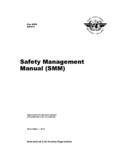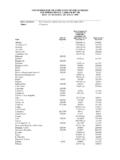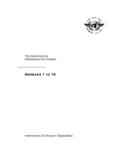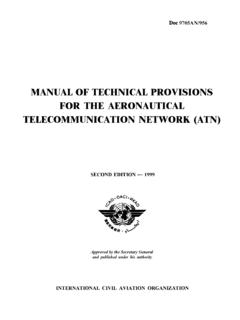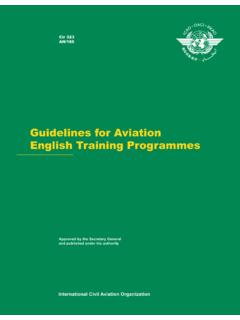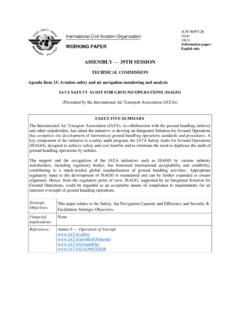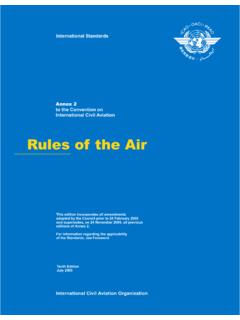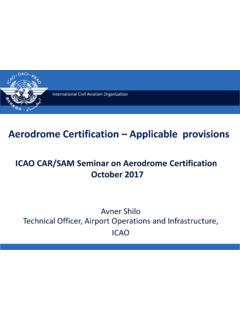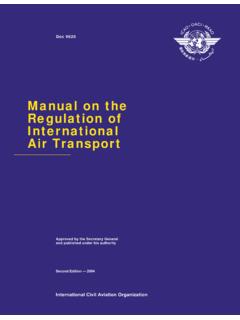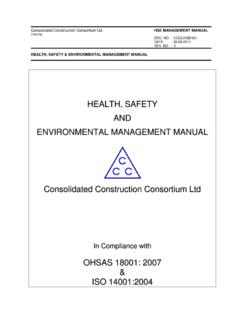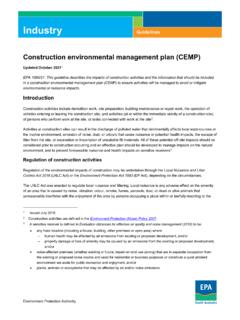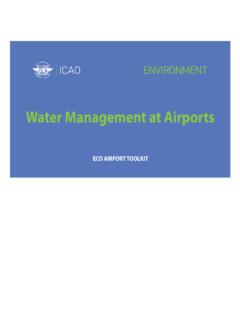Transcription of Introduction to Environmental Management Systems
1 Introduction toEnvironmentalManagementSystems [Best Practice]civil air navigation services organisationContents1_ Foreword_p32_ The Benefits of an EMS_p43_ What is an EMS?_p54_ What is an EMS used for?_p55_ Environment Management Systems and the ANSP_p66_ An ANSP Environmental Management System in Practice Interview with Airservices Australia_p87_ Elements of an Environmental Management System_p108_ Self Assessment_p129_ EMS and Collaboration_p1310_ Conclusion_p1311_ How can CANSO help?_p1312_ Glossary_p14 CANSO 2012 This white paper is for information purposes only. While every effort has been made to ensure the quality and accuracy of information in this publication, it is made available without any warranty of any , CANSO is observing a greater desire for Air Navigation Service Providers (ANSPs)
2 To implement global Systems that assist them to manage the impact their business and operations have on the the need to support ANSPs to manage the Environmental expectations placed upon them, CANSO has developed this Introduction to Environmental Management Systems as a preliminary information package for ANSPs seeking guidance on what is required to establish an industry recognised Environmental Management System (EMS).CANSO acknowledges that many of its members are already advanced in their ability to accurately manage Environmental issues, however we recognise that further information is required if all members are to create consistent Management practices.
3 This document is designed to explain the benefits, the key elements, and best practice when seeking to implement an information compiled in this document has been sourced through questionnaires to CANSO members and developed through wide industry review and input form the CANSO Environment Workgroup. For more information please go to: to Environmental Management SystemsIntroduction to Environmental Management Systemsfor Air Navigation Service Providers2_3 RISK DOCUMENT MANAGE IDENTIFY An EMS helps ANSPs effectively: Identify and assess Environmental issues and risks, Develop and implement appropriate Management for risks (risk treatment, operational control, emergency planning, incident reporting and associated corrective and preventative actions etc), Document risk identification, assessment and Management so that due diligence can be demonstrated, Reduce the use of resources and provide a systematic focus on priorities (cost-effectiveness).
4 2 The Benefits of an EMSAn EMS ensures that an organisation has identified, and is managing, its Environmental risks in a systematic manner. It facilitates: 1. Reduced impact on the environment; 2. Sound (effective and efficient) Environmental performance; 3. Continuous improvement; 4. Meeting legal and other Environmental obligations; and 5. A due diligence approach to Environmental Management for the organisation and its staff. By adopting a systematic and due diligent approach to Environmental Management , ANSPs are able to improve their Environmental performance, reduce business risk and demonstrate improved Environmental performance to stakeholders.
5 Used in consultation with stakeholders an EMS can help to focus priorities and avoid wasted effort leading to reduced operational costs. Furthermore, an EMS can secure growth, support airspace changes, avoid constraints, and help improve quality of life for people around benefits can stem from the cost savings due to better planning and identification of deficiencies, enhancing awareness and skills among employees, plus reduced liability and improved compliance which in turn leads to an improved public image and higher customer an EMS does need an increased investment in staff time and potentially assistance from external consultants.
6 However the long term benefits should outweigh the costs of implementing an effective to Environmental Management Systems3 What is an Environmental Management System?All organisations have some impact on the environment. An EMS is a structured system designed to help an organisation to reduce these impacts through targeted continuous improvement in its Environmental Management , leading to improvements in its Environmental performance, while delivering bottom line benefits through reduced operating EMS is the part of an organisation s overall Management system which enables it to manage its Environmental risks, achieve and control the expected level of Environmental performance and provide a structured process for achievement of continual improvement.
7 An EMS supports Environmental protection, biodiversity conservation, ecologically sustainable development and resource sustainability. An EMS may be certified, registered or incorporated into existing Management Systems and documentation, and can be used to enhance rather than replace existing Systems . In many cases much of an EMS can be provided by existing Management Systems with minimal costs for adjustment. By way of European example, an EMS can be certified by the ISO 14001 international standard or registered under the EU Eco- Management and Audit Scheme (EMAS 1) statute by an auditor in certification of standard or an approved EMAS controller.
8 1 4 What is an EMS used for?The Environmental Management system can be used as an aid to: Identify and reduce the operation s impact on the environment, Introduce controlling routines, Establish tangible Environmental goals for improvement, Introduce an Environmental Management programme in order to achieve Environmental goals, See that Environmental activities are functioning, Continually assess and evaluate Environmental activities, Plan, manage and act using information gained from assessments and evaluations, Create the basis of reliable communication surrounding Environmental activities, Improve negotiation on proposed Environmental Management Systemsand the ANSPAn EMS is a Management tool that can be used by ANSPs to reduce the Environmental impact of their operations and improve their Environmental performance.
9 An EMS can assist an ANSP manage the direct impact of its operations ( asset Management such as fuel storage facilities) and both the direct and indirect impacts of third parties such as airlines and airports - that can be affected by ANSP decisions and service provisions ( changes to aircraft impacts from airspace changes).ANSPs such as Luftfartsverket in Sweden ( ) and Airservices Australia ( ) are progressively implementing an EMS aligned to international standards such as ISO 14001 as an effective tool to facilitate the Management of CNS/ATM Environmental issues. However, as highlighted above, Environmental Management can also be part of an overall Management system and need not specifically be implemented separate to other Management Systems .
10 An organisation that already has, for example, an ISO 9001 Quality Management System, can integrate an EMS as many common elements are shared. This also applies for the Greenhouse Gas Accounting Standard, ISO 14064 and other examples. The new ISO 9004:2009 Managing for sustained success of an organisation also refers to Environmental EMS can be used, but CANSO believes that Systems should be in line with recommended international standards, and at minimum it should assist the ANSP consider the following: What is being done? How does this effect the environment? What is specified in the legislation and regulations? What improvements can be made?
